
The Ames Research Center (ARC), also known as NASA Ames, is a major NASA research center at Moffett Federal Airfield in California's Silicon Valley. It was founded in 1939 as the second National Advisory Committee for Aeronautics (NACA) laboratory. That agency was dissolved and its assets and personnel transferred to the newly created National Aeronautics and Space Administration (NASA) on October 1, 1958. NASA Ames is named in honor of Joseph Sweetman Ames, a physicist and one of the founding members of NACA. At last estimate NASA Ames has over US$3 billion in capital equipment, 2,300 research personnel and a US$860 million annual budget.

Heating, ventilation, and air conditioning (HVAC) is the use of various technologies to control the temperature, humidity, and purity of the air in an enclosed space. Its goal is to provide thermal comfort and acceptable indoor air quality. HVAC system design is a subdiscipline of mechanical engineering, based on the principles of thermodynamics, fluid mechanics, and heat transfer. "Refrigeration" is sometimes added to the field's abbreviation as HVAC&R or HVACR, or "ventilation" is dropped, as in HACR.

A furnace, referred to as a heater or boiler in British English, is an appliance used to generate heat for all or part of a building. Furnaces are mostly used as a major component of a central heating system. Furnaces are permanently installed to provide heat to an interior space through intermediary fluid movement, which may be air, steam, or hot water. Heating appliances that use steam or hot water as the fluid are normally referred to as a residential steam boilers or residential hot water boilers. The most common fuel source for modern furnaces in North America and much of Europe is natural gas; other common fuel sources include LPG, fuel oil, wood and in rare cases coal. In some areas electrical resistance heating is used, especially where the cost of electricity is low or the primary purpose is for air conditioning. Modern high-efficiency furnaces can be up to 98% efficient and operate without a chimney, with a typical gas furnace being about 80% efficient. Waste gas and heat are mechanically ventilated through either metal flue pipes or polyvinyl chloride (PVC) pipes that can be vented through the side or roof of the structure. Fuel efficiency in a gas furnace is measured in AFUE.

Ventilation is the intentional introduction of outdoor air into a space. Ventilation is mainly used to control indoor air quality by diluting and displacing indoor pollutants; it can also be used to control indoor temperature, humidity, and air motion to benefit thermal comfort, satisfaction with other aspects of indoor environment, or other objectives.
A solar chimney – often referred to as a thermal chimney – is a way of improving the natural ventilation of buildings by using convection of air heated by passive solar energy. A simple description of a solar chimney is that of a vertical shaft utilizing solar energy to enhance the natural stack ventilation through a building.
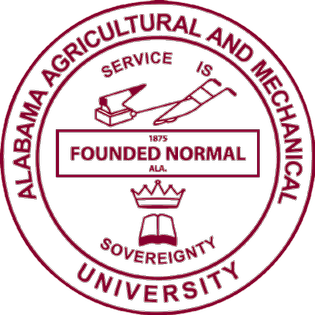
Alabama Agricultural and Mechanical University is a public historically black land-grant university in Normal, Alabama. Founded in the 1875 as a normal school, it took its present name in 1969. AAMU is a member-school of the Thurgood Marshall College Fund and is accredited by the Southern Association of Colleges and Schools. Alabama Agricultural and Mechanical University Historic District, also known as Normal Hill College Historic District, has 28 buildings and four structures listed in the United States National Register of Historic Places.
A sound attenuator, or duct silencer, sound trap, or muffler, is a noise control acoustical treatment of Heating Ventilating and Air-Conditioning (HVAC) ductwork designed to reduce transmission of noise through the ductwork, either from equipment into occupied spaces in a building, or between occupied spaces.
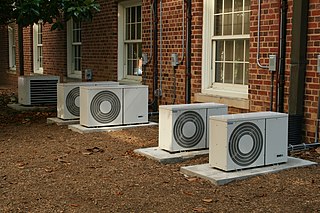
Air conditioning, often abbreviated as A/C or AC, is the process of removing heat and controlling the humidity of air in an enclosed space to achieve a more comfortable interior environment by use of powered "air conditioners" or a variety of other methods, including passive cooling and ventilative cooling. Air conditioning is a member of a family of systems and techniques that provide heating, ventilation, and air conditioning (HVAC).

Passive ventilation is the process of supplying air to and removing air from an indoor space without using mechanical systems. It refers to the flow of external air to an indoor space as a result of pressure differences arising from natural forces.
Building services engineering is a professional engineering discipline that strives to achieve a safe and comfortable indoor environment whilst minimizing the environmental impact of a building.

The Ellen H. Swallow Richards House is a National Historic Landmark house at 32 Eliot Street in Jamaica Plain, a neighborhood of Boston, Massachusetts. It was the home of Ellen Swallow Richards (1842–1911) from 1876 until her death. Richards was the first woman to graduate from the Massachusetts Institute of Technology, and was its first female instructor. She introduced revolutionary ideas about home sanitation, and conducted pioneering work that led to the establishment of the field of home economics. The house itself was regularly altered as a consequence of her research, and was used by Richards as a consumer product testing laboratory. It was designated a National Historic Landmark in 1992.

Sprague's Super Service is a historic independent gas station on Route 66 in Normal, Illinois.
BSRIA is a UK-based testing, instrumentation, research and consultancy organisation, providing specialist services in construction and building services engineering. It is a not-for-profit, member-based association, with over 650 member companies; related services are delivered by a trading company, BSRIA Limited. Any profits made are invested in its research programme, producing best practice guidance.
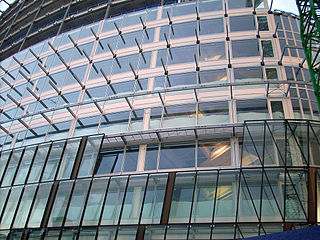
The double-skin facade is a system of building consisting of two skins, or facades, placed in such a way that air flows in the intermediate cavity. The ventilation of the cavity can be natural, fan supported or mechanical. Apart from the type of the ventilation inside the cavity, the origin and destination of the air can differ depending mostly on climatic conditions, the use, the location, the occupational hours of the building and the HVAC strategy.

Mechanical systems drawing is a type of technical drawing that shows information about heating, ventilating, air conditioning and transportation around the building. It is a powerful tool that helps analyze complex systems. These drawings are often a set of detailed drawings used for construction projects; it is a requirement for all HVAC work. They are based on the floor and reflected ceiling plans of the architect. After the mechanical drawings are complete, they become part of the construction drawings, which is then used to apply for a building permit. They are also used to determine the price of the project.

Arthur Cutts Willard was the ninth president of the University of Illinois and an innovator in the field of heating and ventilation. Known for being approachable, a gentleman and well-dressed; he was known and admired by many. He received worldwide acclaim for his research and contribution to the heating, ventilating field; in particular for his contributions to the Holland Tunnel. In addition to his contributions to heating and ventilation industry, Willard was an educator in heating and ventilation and mechanical engineering between 1906 and 1933. He taught at George Washington University and the University of Illinois. Willard was appointed president in 1934 and served until 1946. Although he served as president during a difficult time for the university and the nation, he continued to have the highest expectations of his students. During his time as president he obtained funding for construction and addition of many buildings on the University of Illinois campuses. Willard strongly believed education needed to be more broad and focus on the social and economic problems facing the nation. At the end of service to the university, the Institute of Aviation was established at University of Illinois Willard Airport, and it was named in honor of A.C. Willard.
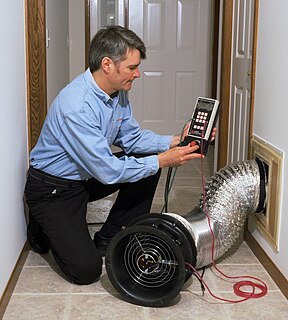
A duct leakage tester is a diagnostic tool designed to measure the airtightness of forced air heating, ventilating and air-conditioning (HVAC) ductwork. A duct leakage tester consists of a calibrated fan for measuring an air flow rate and a pressure sensing device to measure the pressure created by the fan flow. The combination of pressure and fan flow measurements are used to determine the ductwork airtightness. The airtightness of ductwork is useful knowledge when trying to improve energy conservation.
The Uniform Mechanical Code (UMC) is a model code developed by the International Association of Plumbing and Mechanical Officials (IAPMO) to govern the installation, inspection and maintenance of HVAC and refrigeration systems. It is designated as an American National Standard.
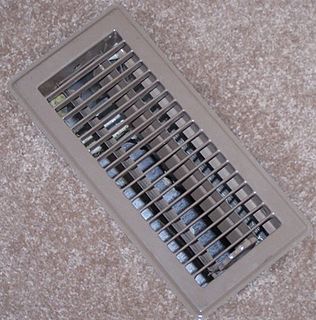
A register is a grille with moving parts, capable of being opened and closed and the air flow directed, which is part of a building's heating, ventilation, and air conditioning (HVAC) system. The placement and size of registers is critical to HVAC efficiency. Register dampers are also important, and can serve a safety function.

Thermotank was a Scottish engineering company specialising in heating, ventilation and air conditioning, founded in Glasgow in 1900 by Alexander William Stewart and his two brothers William and Frederick. The business was based on Alexander’s invention, the Thermotank, a system designed for maritime use which could maintain a constant temperature coupled to a change of air on board ships.

















